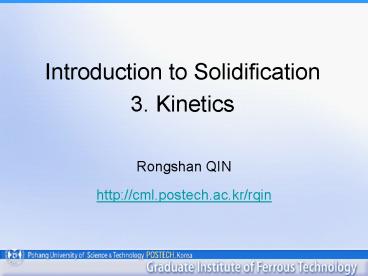Introduction to Solidification 3. Kinetics PowerPoint PPT Presentation
1 / 30
Title: Introduction to Solidification 3. Kinetics
1
Introduction to Solidification3. Kinetics
- Rongshan QIN
- http//cml.postech.ac.kr/rqin
1
2
In this lecture
- Homogeneous nucleation
- Heterogeneous nucleation
3
Solidification
- Two types of solidification
Viscosity vs. temperature in (a) Glass
formation. (b) Metal casting.
4
Solidification
Temperature
liquid
Glass formation
Metal casting
solid
time
Temperature vs. time during solidification
5
Solidification
Molecular/atom arrangements in (a) Glass. (b)
Crystal.
6
Metal solidification
- Nucleation
- Growth
7
Homogeneous nucleation
- No preferred nucleation sites
- Spontaneous
- Random
- Those of preferred sites
- Boundary
- Surface
- Inclusion,
8
Local free energy change
1. Liquid to solid
2. Interface
9
Local free energy change
Spherical nucleus
10
Single nucleus
11
Critical radius
12
(GL-GS) vs. supercooling
Free energy density vs. temperature
13
Parameters
For FCC Copper, r?1 nm, which contains 310 Cu
atoms in each nucleus.
14
System free energy
- Ideal solution Particle of different sizes
- ni particles with each contains i atoms
- n particles with each contains 1 atom
15
Number of nuclei
- At equilibrium
16
Number of nuclei
when
Boltzmann formula
Critical nuclei
17
Heterogeneous nucleation
- Nucleation site
- Mold walls
- Inclusion
- Interface
- Surface
- Impurity
18
Heterogeneous nucleation
19
Heterogeneous nucleation
Force equilibrium
where ?IL, ?IN and ?NL are the interface energies
of inclusion-liquid, inclusion-nucleus and
nucleus-liquid, respectively. ? is the
nucleus-inclusion wetting angle. The nucleus is a
spherical cap of radius r.
20
Free energy change
21
Free energy change
Using
22
Thermodynamic barriers
Heterogeneous nucleation barrier
Homogeneous nucleation barrier
23
Thermodynamic barrier vs. wetting angle
24
(No Transcript)
25
Number of nuclei with critical radius
where ns is the total number of atom around the
incubating agents surface in liquid.
26
Inoculating agents
- Small interface energy
- Similar crystal structure
- Similar lattice distance
- Same physical properties
- Same chemical properties
27
Effect of surface geometry
28
Casting refinement
- Adding inoculating agents
- Overheat might melt the agents
- Surface refinement
- Coat agents on mold walls
- Pattern induced solidification
29
In summary
- Two types of solidification
- Glass formation
- crystallization
- Solidification
- Nucleation
- Growth
- Homogeneous and heterogeneous nucleation
30
References
- M.C. Flemings, Solidification processing, 1974.
- A. L. Greer, Kinetics, Cambridge.

